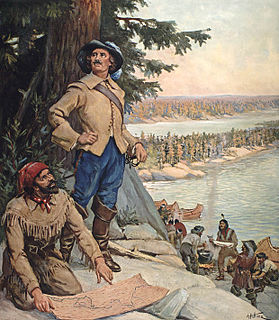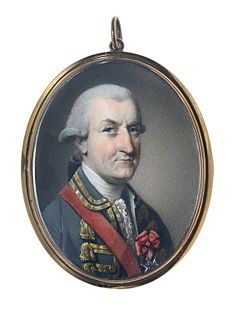
Pierre Gaultier de Varennes, sieur de La Vérendrye was a French Canadian military officer, fur trader and explorer. In the 1730s, he and his four sons explored the area west of Lake Superior and established trading posts there. They were part of a process that added Western Canada to the original New France territory that was centred along the Saint Lawrence basin.

This section of the Timeline of Quebec history concerns the events relating to the Quebec portion of New France between the establishment of the Sovereign Council and the fall of Quebec.
Jean-Pierre Aulneau de la Touche was a Jesuit missionary priest who was briefly active in New France and killed before he could take part in his first major assignment which was to be an expedition to the Mandan. He died near Fort St. Charles, on Lake of the Woods in an area now in Ontario, Canada and Minnesota, United States. He was killed while traveling with Jean Baptiste de La Vérendrye, and is often referred to as "Minnesota's Forgotten Martyr."

Louis-Joseph Gaultier de La Vérendrye was a French Canadian fur trader and explorer. He, his three brothers, and his father Pierre La Vérendrye pushed trade and exploration west from the Great Lakes. He, his brother, and two colleagues are thought to be the first Europeans to have crossed the northern Great Plains and seen the Rocky Mountains in Wyoming.

Jean-Baptiste Gaultier de la Vérendrye was the eldest son of Pierre Gaultier de Varennes et de La Vérendrye and Marie-Anne Dandonneau Du Sablé. He was born on Île Dupas near Sorel, New France

Pierre Gaultier de La Vérendrye de Boumois was the second son of Pierre Gaultier de Varennes, sieur de La Vérendrye. An explorer and fur trader who served many years under the command of his father, he was born on Île aux Vaches, near Sorel, New France.
François de La Vérendrye was a Canadian explorer. He was the third son of Pierre Gaultier de Varennes, sieur de La Vérendrye. He was born at Sorel, New France in 1715 and was active in his father's trade activities from Fort Kaministiquia to the North Saskatchewan River.
Nicolas-Joseph de Noyelles originally resided in Rochefort, France but came to New France in 1710 to begin his military career as an ensign in the regular colonial troops. He married in 1718 and, because of a strong family friendship with Governor Charles de Beauharnois, he received favorable postings and promotions. His two main postings were Detroit and (near) Fort Wayne. At Fort Wayne, he became heavily involved in the fur trade. He was also involved in trying to settle wars and allegiances amongst various Indian tribes. It would seem that much of his activity in this area pointed to a high level of ineptness. However, the Beauharnois connection stood him in good stead. In 1744, when Pierre Gaultier de Varennes et de La Vérendrye lost the western commanders position of directing the fur trade while exploring a route to the western sea, the position was granted to Noyelles. However, this was a demanding job and he resigned in 1746.

Louis de la Corne or Louis Chapt, Chevalier de la Corne was born at Fort Frontenac in what is now Kingston, Ontario, Canada, and began his career in the colonial regular troops as a second ensign in 1722 and was made full ensign five years later.

Fort La Reine was built in 1738 and is one of the forts of the western expansion directed by Pierre Gaultier de Varennes et de La Vérendrye, first military commander in the west of what is now known as Canada. Located on the Assiniboine River where present day Portage la Prairie, Manitoba, stands, the fort served as a fur trading post. It was also the base of operations for much exploration north and west. From Fort La Reine, explorers made their way to Lake Manitoba and Lake Winnipegosis, Lake Winnipeg and the Saskatchewan River.
Fort La Jonquière was a French fort built along the Saskatchewan River in the spring of 1751. It was purported to have been the furthest west outpost of New France. The fort was named after the Governor General of New France at the time, Jacques-Pierre de Taffanel de la Jonquière, Marquis de la Jonquière, by Jacques Legardeur de Saint-Pierre, western commander of the French (1750-1753). There is no surviving record of its exact location, nor physical evidence, but it was most likely located near Nipawin, Saskatchewan.

Fort Maurepas was the name of two forts, or one fort in two locations, built by the French in the Lake Winnipeg area in the 1730s. They were both named after Jean-Frédéric Phélypeaux, Count of Maurepas who, as Minister of Marine, was in charge of French colonies and chief adviser to King Louis XVI.

Fort Dauphin, was built in 1741 near Winnipegosis, Manitoba with Pierre Gaultier de La Vérendrye, the western military commander, directing construction. The area provided a post located between the Assiniboine River and the Saskatchewan River. It was named for the Dauphin prince of France.

Fort Paskoya or Paskoyac or Pasquia was a French fort and trading post on the lower Saskatchewan River above Cedar Lake. Around 1740 La Vérendrye built four forts to control the chain of lakes west of Lake Winnipeg. These were Fort Pascoya, Fort Bourbon, Fort Dauphin and Fort La Reine. Their purpose was to trade in furs and to divert to Montreal furs that had previously gone to the English on Hudson Bay. Pascoya had a good location because most of the furs from the west and northwest came down the Saskatchewan. The forts were also part of a quest for a river that led to the western sea, which Verendrye now thought was the Saskatchewan.

Fort Saint Pierre on Rainy Lake was the first French fort built west of Lake Superior. It was the first of eight forts built during the elder Vérendrye's expansion of trade and exploration westward from the Great Lakes.

Luc de la Corne, also known as Saint Luc, was the son of Jean-Louis de La Corne de Chaptes (1666-1732), King's Lieutenant at Montreal, and Marie Pécaudy de Contrecœur. Saint-Luc was an officer in the Compagnies Franches de la Marine; his brother Louis de la Corne, Chevalier de la Corne, later became a very successful merchant at Montreal. Though relatively unknown, he played a major role in American and Canadian history. He is most famous for returning from the shipwreck of the Auguste off the coast of Cape Breton, Nova Scotia, at the age of fifty, during the dead of winter, to Quebec City - a trek of 700 miles. He had a varied and courageous military career which earned him the cross of Saint Louis in 1759. He fought at both the Battle of Fort William Henry during the French and Indian War and at the Battle of Saratoga during the American Revolution.
Fort Rouge was a fort located on the Assiniboine River in Manitoba, Canada, on the site of what is now the city of Winnipeg. Its exact location is unknown. Its name in English means "red fort".
Verendrye National Monument was a federally protected area in the U.S. state of North Dakota from 1917 to 1956. In the latter year it was withdrawn as a national monument. It is located in southwestern Mountrail County, west of the city of New Town. It lies within the Fort Berthold Indian Reservation.
Charles-Michel Mesaiger was a French Jesuit priest who spent some time in missionary work in present-day Canada.
The Vérendrye brothers were the first Europeans to cross the northern Great Plains and see the Rocky Mountains (1742–1743). We know very little about their journey. All we know comes from a journal found in the French archives in 1851 and a lead plate commemorating the journey which was found in 1913 buried near Pierre, South Dakota. The journal and lead plate are difficult to interpret. The journal states the trip may have been made by the "Chevalier Vérendrye and one of his brothers" who are otherwise unidentified. Most likely the Chevalier was Louis-Joseph Gaultier de La Vérendrye and the brother was François de La Vérendrye but we cannot be sure. The mountains they saw during their expeditions may have been the Big Horn Mountains of Wyoming, but could also have been the Black Hills or the Laramie Mountains










